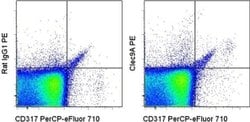Learn More
Invitrogen™ CD370 (Clec9A) Monoclonal Antibody (42D2), PE, eBioscience™
Rat Monoclonal Antibody
Supplier: Invitrogen™ 12597582

Description
Description: This 42D2 monoclonal antibody reacts with mouse CD370, which is also known as DNGR-1 or Clec9A. CD370 is a C-type lectin-like receptor expressed on conventional and plasmacytoid dendritic cells (DCs). In particular, CD8+ conventional DCs in the thymus, spleen, and lymph nodes, as well as CD24+ DCs in the blood, express CD370. This receptor is not detectable on most B cells, T and NK cells, monocytes, and macrophages. The cytoplasmic domain of CD37°Contains an ITAM motif that has been demonstrated to phosphorylate Syk tyrosine kinase, leading to NFAT activation. This signaling reportedly mediates the presentation of necrotic cell-associated antigens by CD8+ DCs in innate immunity. Applications Reported: This 42D2 antibody has been reported for use in flow cytometric analysis. Applications Tested: This 42D2 antibody has been tested by flow cytometric analysis of mouse splenocytes. This can be used at less than or equal to 1 μg per test. A test is defined as the amount (μg) of antibody that will stain a cell sample in a final volume of 100 μL. Cell number should be determined empirically but can range from 10^5 to 10^8 cells/test. It is recommended that the antibody be carefully titrated for optimal performance in the assay of interest. Excitation: 488-561 nm; Emission: 578 nm; Laser: Blue Laser, Green Laser, Yellow-Green Laser. Filtration: 0.2 μm post-manufacturing filtered.
C-type lectin domain family 9 member A (CLEC9A) is a gene located on chromosome 12p13.2, encoding a protein that belongs to the C-type lectin receptor family. CLEC9A is primarily expressed on dendritic cells and certain subsets of macrophages, playing a pivotal role in the immune system by recognizing and binding dead cell debris, including necrotic cells. This receptor facilitates the presentation of antigens derived from dead cells to T cells, thus contributing to the initiation of immune responses. CLEC9A is involved in cross-presentation, a process crucial for adaptive immunity, particularly in the context of viral infections and cancer. Its expression and activity are of particular interest for vaccine development and immunotherapy, given its ability to enhance antigen presentation and stimulate robust immune responses. Research into CLEC9A continues to explore its therapeutic potential for modulating immune activity in various diseases, including cancer and infectious diseases.
Specifications
| CD370 (Clec9A) | |
| Monoclonal | |
| 0.2 mg/mL | |
| PBS with 0.09% sodium azide; pH 7.2 | |
| Q8BRU4 | |
| CLEC9A | |
| Affinity chromatography | |
| RUO | |
| 232414 | |
| 4°C, store in dark, DO NOT FREEZE! | |
| Liquid |
| Flow Cytometry | |
| 42D2 | |
| PE | |
| CLEC9A | |
| 9830005G06Rik; CD370; Clec9a; C-type lectin domain family 9 member A; C-type lectin domain family 9, member A; Dendritic cell natural killer lectin group receptor 1; DNGR1; DNGR-1; HEEE9341; RGD1562513; UNQ9341; UNQ9341/PRO34046 | |
| Rat | |
| 100 μg | |
| Primary | |
| Mouse | |
| Antibody | |
| IgG1 |
The Fisher Scientific Encompass Program offers items which are not part of our distribution portfolio. These products typically do not have pictures or detailed descriptions. However, we are committed to improving your shopping experience. Please use the form below to provide feedback related to the content on this product.
